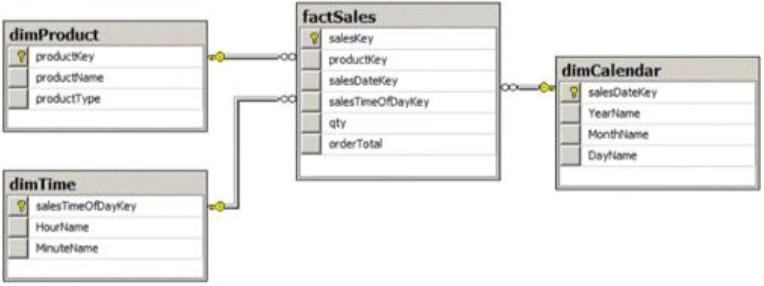File Info
| Exam | Implementing a Data Warehouse with Microsoft SQL Server 2012/2014 |
| Number | 70-463 |
| File Name | Microsoft.70-463.Pass4Sure.2018-06-15.132q.tqb |
| Size | 2 MB |
| Posted | Jun 15, 2018 |
| Download | Microsoft.70-463.Pass4Sure.2018-06-15.132q.tqb |
How to open VCEX & EXAM Files?
Files with VCEX & EXAM extensions can be opened by ProfExam Simulator.
Coupon: MASTEREXAM
With discount: 20%





Demo Questions
Question 1

You are reviewing the design of an existing fact table named factSales, which is loaded from a SQL Azure database by a SQL Server Integration Services (SSIS) package each day. The fact table has approximately 1 billion rows and is dimensioned by product, sales date, and sales time of day.

The database administrator is concerned about the growth of the database. Users report poor reporting performance against this database. Reporting requirements have recently changed and the only remaining report that uses this fact table reports sales by product name, sale month, and sale year. No other reports will be created against this table.
You need to reduce the report processing time and minimize the growth of the database.
What should you do?
- Partition the table by product type.
- Create a view over the fact table to aggregate sales by month.
- Change the granularity of the fact table to month.
- Create an indexed view over the fact table to aggregate sales by month.
Correct answer: C
Question 2
You are designing a data warehouse with two fact tables. The first table contains sales per month and the second table contains orders per day.
Referential integrity must be enforced declaratively.
You need to design a solution that can join a single time dimension to both fact tables.
What should you do?
- Create a time mapping table.
- Change the level of granularity in both fact tables to be the same.
- Merge the fact tables.
- Create a view on the sales table.
Correct answer: B
Explanation:
Microsoft SQL Server Analysis Services, a time dimension is a dimension type whose attributes represent time periods, such as years, semesters, quarters, months, and days. The periods in a time dimension provide time-based levels of granularity for analysis and reporting. The attributes are organized in hierarchies, and the granularity of the time dimension is determined largely by the business and reporting requirements for historical data References: https://docs.microsoft.com/en-us/sql/analysis-services/multidimensional-models/database-dimensions-create-a-date-type-dimension Microsoft SQL Server Analysis Services, a time dimension is a dimension type whose attributes represent time periods, such as years, semesters, quarters, months, and days. The periods in a time dimension provide time-based levels of granularity for analysis and reporting. The attributes are organized in hierarchies, and the granularity of the time dimension is determined largely by the business and reporting requirements for historical data
References: https://docs.microsoft.com/en-us/sql/analysis-services/multidimensional-models/database-dimensions-create-a-date-type-dimension
Question 3
You are designing a data warehouse for a software distribution business that stores sales by software title. It stores sales targets by software category. Software titles are classified into subcategories and categories. Each software title is included in only a single software subcategory, and each subcategory is included in only a single category. The data warehouse will be a data source for an Analysis Services cube.
The data warehouse contains two fact tables:
- factSales, used to record daily sales by software title
- factTarget, used to record the monthly sales targets by software category
Reports must be developed against the warehouse that reports sales by software title, category and subcategory, and sales targets.
You need to design the software title dimension. The solution should use as few tables as possible while supporting all the requirements.
What should you do?
- Create three software tables, dimSoftware, dimSoftwareCategory, and dimSoftwareSubcategory and a fourth bridge table that joins software titles to their appropriate category and subcategory table records with foreign key constraints. Direct the cube developer to use key granularity attributes.
- Create three software tables, dimSoftware, dimSoftwareCategory, and dimSoftwareSubcategory. Connect factSales to all three tables and connect factTarget to dimSoftwareCategory with foreign key constraints. Direct the cube developer to use key granularity attributes.
- Create one table, dimSoftware, which contains Software Detail, Category, and Subcategory columns. Connect factSales to dimSoftware with a foreign key constraint. Direct the cube developer to use a non-key granularity attribute for factTarget.
- Create two tables, dimSoftware and dimSoftwareCategory. Connect factSales to dimSoftware and factTarget to dimSoftwareCategory with foreign key constraints. Direct the cube developer to use key granularity attributes.
Correct answer: C

